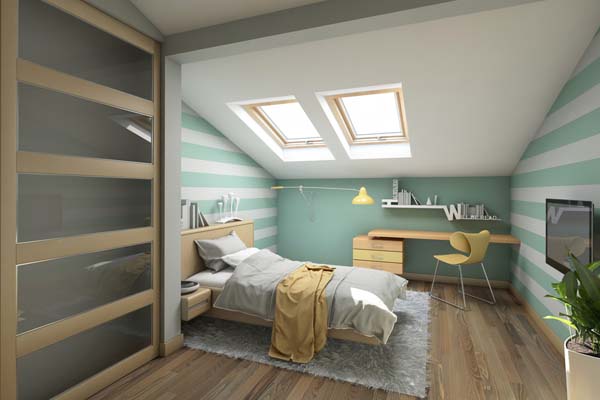Attic Air Conditioner: What You Should Be Looking For?

If you thinking of converting your attic into a usable space, then one factor to consider is how you will keep your attic cool. Naturally, no one wants to spend a fortune on cooling, so you will want to find something that will provide a high level of comfort in an efficient manner. However, finding the right attic air conditioner requires careful consideration of specific features and factors. From its size and energy efficiency to installation requirements and compatibility with your existing HVAC system, understanding these factors can help you make wise decisions. In this article, we explore the key aspects you should be looking for when selecting an attic air conditioner. So, let’s delve into the essential features that deserve your attention.
Attic Air Conditioner: What You Should Be Looking For?
Contents
The attic presents a unique environment for cooling. Choose an air conditioner that is designed explicitly for attic installation. Remember to check local building codes and regulations related to attic air conditioner installations for compliance and safety. Better yet, speak to an experienced HVAC contractor for the best results.
Related Article: Ductless Mini-Split Lifespan: How Long Should My Unit Last?
Air Conditioner Size & Capacity

Work with an HVAC contractor to calculate the cooling capacity required for your attic. The factors that influence cooling capacity include size, insulation, heat load, and more. Make sure the air conditioner you choose can effectively cool the space without overworking or underperforming.
Related Article: How Do Ductless Air Conditioners Work?
Energy Efficiency & Air Conditioner SEER Rating
Opt for an energy-efficient model to reduce your electricity bills and minimize environmental impact. Look for units with a high Seasonal Efficiency Ratio (SEER) rating, as higher ratings indicate better energy efficiency.
Compact AC Unit Design
Attics usually have limited space, so choose an AC unit with a compact design that can fit easily within the available space. This will make installation and maintenance more convenient.
Related Article: How Many Zones Can A Mini-Split Have?
Ductless or Mini-Split System

Attics often lack the necessary ductwork for traditional central air conditioning systems. Consider a ductless or mini-split air conditioner, which consists of an outdoor unit and one or more indoor units. These systems are more flexible and easier to install in attics without major renovations. Furthermore, they offer impressive SEER rating, low operational costs, and incredible levels of comfort.
Condensation Management
Attics can be prone to high humidity levels, which can lead to condensation issues. Look for a cooling system with proper condensation management features, like a condensate pump or drainage system, to prevent moisture-related problems. Ask your local HVAC company about this aspect.
Related Article: The Challenges Of Cooling Historic Homes
Air Conditioning Noise Level
Consider the noise level the air conditioner will produce, especially if your attic is adjacent to living spaces. Look for models with noise-reduction features, such as insulated compressor compartments or variable speed fans, to minimize disruptive noise.
Why You Need an Attic Air Conditioner
An attic air conditioner is a necessary addition for optimal comfort and temperature control in your home. Attics accumulate excessive heat, making them uncomfortable spaces and potentially affecting the overall temperature of your living areas.
By installing an AC unit in your attic, you can:
- Make your attic more usable for storage
- Use your attic as an extra living space
- Prevent overburdening your main cooling system
Related Article: The Top 7 Benefits Of A Ductless Split System
Types of Air Conditioners for Your Attic
There are a few different options when choosing an AC unit for your attic based on the specific requirements and constraints of your space. Here are four types of AC units suitable for attic installations:
- Ducted Split System: This type of AC system consists of a central unit connected to ductwork throughout your home, including the attic. The central unit is typically installed outside or in a mechanical room, while the cooled air is distributed through vents in different rooms via ductwork. Ducted split systems are suitable for larger attics or to cool multiple rooms in the attic space. You have to make sure that the attic has sufficient space for the ductwork and proper insulation to minimize energy loss.
- Ductless Mini-Split System: Ductless mini-split systems are popular for attic installations, especially when ductwork is not feasible or desirable. These systems consist of an outdoor condenser unit and one or more indoor handling units installed in the attic. The indoor unit(s) are connected to the outdoor unit by refrigerant lines, requiring only a small hole to pass through the attic wall. Ductless systems offer flexibility in zoning, allowing you to heat and cool specific areas of the home. They are energy-efficient, easy to install, and provide quiet operation. These systems are an excellent choice for those who need attic air conditioning and heating.
- Portable Air Conditioner: Portable AC units are self-contained units that can be moved around as needed. They typically consist of a single unit with an exhaust hose that needs to be vented outside through a window or opening in the attic. Portable AC systems are relatively easy to install and are suitable for smaller attics or temporary cooling needs. However, they may be less efficient compared to other options and require proper venting to remove hot air from the attic. Due to their lack of efficiency and low performance, they are not recommended.
- Through-the-Wall AC Unit: Through-the-wall air conditioners are standalone units designed to be mounted directly through an exterior wall. These units have a built-in compressor and cooling system and require an external opening in the wall for ventilation. Through-the-wall AC units are suitable for smaller attics or specific areas within the attic that require cooling. They are easy to install and offer a space-saving solution. However, they are quite noisy, expensive to operate, and create the ideal environment for mold growth, impacting indoor air quality. Therefore, these systems are now considered outdated by experts. HVAC contractors would steer you in the direction of a more modern and efficient cooling unit, such as the ductless mini-split.
Importance of Proper Insulation & Sealing
Proper insulation and sealing are of utmost importance when installing an attic AC system. Properly insulating the attic creates a thermal barrier that prevents heat transfer between the attic and the rest of the house. The insulation helps keep the air-conditioned air inside the living spaces, reducing the workload on the AC system and resulting in energy savings.
Sealing is equally significant because it prevents air leakage and infiltration in the attic. Air leaks occur through gaps, cracks, or improperly sealed areas, causing conditioned air to escape and unconditioned air to enter the attic. Sealing these gaps and cracks creates a more airtight space, allowing the attic air conditioner to function efficiently. Sealing also aids in better air distribution within the attic, ensuring even cooling throughout the space.
Proper insulation and sealing help mitigate moisture-related issues like condensation, which can lead to mold growth, structural damage, and compromise insulation effectiveness. Maintaining a dry and well-sealed attic creates a healthier living environment and reduces the risk of costly repairs. Investing in these measures enhances the performance and longevity of your attic AC while creating a more comfortable and sustainable home environment.
Conclusion
Considering all the factors we have discussed regarding attic air conditioners is essential for a successful installation. Factors such as temperature control, energy efficiency, protection of belongings, moisture control, and proper insulation and sealing are all important considerations. To navigate these factors and make wise decisions, consult your trusted HVAC contractor. Their expertise and guidance will help you select the right type of AC unit, properly size and install it, and optimize its performance in your attic. Consulting an HVAC professional will help you make informed and wise decisions, leading to a comfortable and efficient cooling solution for your attic.
Related Article: Using Ductless As A Supplemental Heat Source
Call McAllister Energy For All Of Your HVAC Requirements

McAllister Energy offers superior heating and cooling services throughout southern New Jersey. We hire the best-certified technicians who can provide you with excellent HVAC tune-ups, repairs, installations, and replacements. Each of our techs has the knowledge and experience to service your HVAC system correctly.
McAllister Energy guarantees the most competitive heating and cooling service costs in the area. Our maintenance services can improve your comfort and increase your energy efficiency while reducing your home heating and cooling costs. If you happen to need an HVAC repair or replacement system, we can recommend the best one for your home while staying within your budget. We back all of our work with a guarantee to ensure your satisfaction. To schedule a service appointment, give McAllister Energy a call today. We offer free, in-home estimates.
You can click here to contact us now or call us at (856) 665-4545 to find out more! Click the link to view our service area.